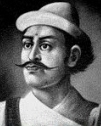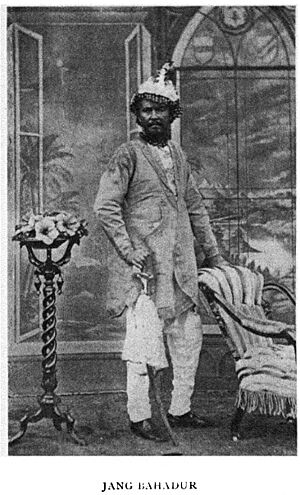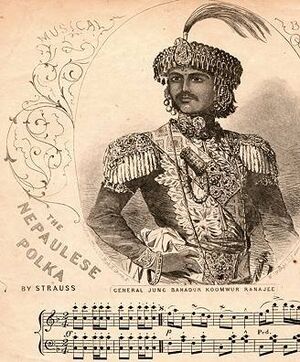Jung Bahadur Rana facts for kids
Quick facts for kids
Jung Bahadur Rana
Ranaji
|
|
|---|---|

Jung Bahadur Rana in 1887
|
|
| 8th Prime Minister of Nepal | |
| Maharaja of Kaski and Lamjung | |
| In office 15 September 1846 – 1 August 1856 |
|
| Monarch | King Rajendra King Surendra |
| Preceded by | Fateh Jung Shah |
| Succeeded by | Bam Bahadur Kunwar |
| In office 28 June 1857 – 25 February 1877 |
|
| Monarch | King Surendra |
| Preceded by | Bam Bahadur Kunwar |
| Succeeded by | Ranodip Singh Kunwar |
| Personal details | |
| Born | 18 June 1817 Balkot, Arghakhanchi district, Kingdom of Nepal |
| Died | 25 February 1877 (aged 59) Patharghat, Rautahat, Kingdom of Nepal |
| Spouses | Nanda Kumari (second wife); Hiranya Garbha Devi (ninth wife) |
| Children | Jagat Jung Rana, Lalit Rajeshwori Rajya Lakshmi Devi, Somgarva Divyeshwari Rajya Laxmi, Padma Jung Bahadur Rana, Badan Kumari, Jit Jung Rana |
| Relatives | See Kunwar family; see Thapa dynasty; see Rana dynasty |
Jung Bahadur Rana (born Bir Narsingh Kunwar) was an important leader in Nepalese history. He became the Prime Minister of Nepal in 1846. His original name was Bir Narsingh Kunwar. His uncle, Mathabarsingh Thapa, gave him the name Jang Bahadur.
Jung Bahadur Rana helped change Nepal's government. He ended many fights among powerful families at the royal court. He also made new rules for the government and courts. Many historians see him as a key figure in modernizing Nepal.
Contents
Jung Bahadur Rana's Early Life
Jung Bahadur was born on June 18, 1817. His birthplace was Balkot in southern Nepal. His father was Bal Narsingh Kunwar, who was a bodyguard for King Rana Bahadur Shah. His mother was Ganesh Kumari.
Family Background
Jung Bahadur came from a family of important military leaders. His ancestors, Kaji Ranajit Kunwar and Sardar Ram Krishna Kunwar, were famous under King Prithvi Narayan Shah. His mother, Ganesh Kumari, was related to the powerful Thapa dynasty. Her father was Kaji Nain Singh Thapa.
Bal Narsingh, Jung Bahadur's father, was rewarded for his bravery. He was given the special title of Kaji. This meant he could carry weapons inside the palace. In 1833, Jung Bahadur joined the military. He was promoted to second lieutenant by 1835.
However, when his uncle Bhimsen Thapa lost power in 1837, Jung Bahadur and his family also lost their jobs. Their property was taken away. Jung Bahadur traveled to Varanasi to find work. He later returned to Nepal and eventually came back to Kathmandu in 1839.
Jung Bahadur Rana's Rise to Power
In 1839, Jung Bahadur married. This helped him improve his financial situation. In 1840, he met King Rajendra during a trip. Jung Bahadur impressed the King with his daring actions. The King made him a captain.
Later, Jung Bahadur became a Kaji and worked in the financial office. This gave him a chance to learn about Nepal's money matters. He was very ambitious. He worked hard to please the Queen, the Prince, and the Prime Minister. He also made friends with important British officials.
Jung Bahadur had a disagreement with his uncle, Mathavar Singh. This led to him holding a grudge. He also became friends with the palace priest, Pandit Bijayaraj. This helped him learn important information about the royal court. He also befriended Gagan Singh Khawaas, another powerful figure.
After Mathavar Singh was killed, the Queen made Jung Bahadur a General. She also included Gagan Singh in her group of advisors.
The Kot Massacre
A very important event called the Kot massacre happened on September 14, 1846. Jung Bahadur Rana and his brothers killed about 40 people at the palace armory in Kathmandu. These people included the Prime Minister, Chautariya Fateh Jung Shah, and other members of the royal court.
This event made King Rajendra Bikram Shah and Surendra Bikram Shah lose their power. It also marked the beginning of the Rana dynasty rule in Nepal. By 1850, Jung Bahadur had removed his main rivals. He put his own chosen person on the throne. He also gave important jobs to his brothers and friends. This made sure he was in charge of all major government decisions.
Jung Bahadur Rana as Prime Minister
After the Kot Massacre, Jung Bahadur was made Prime Minister and Commander-in-chief on September 15. He met with the British Resident to assure him of good relations. He then appointed his family members to high government positions.
The Bhandarkhal Massacre
The Queen wanted Jung Bahadur to remove Prince Surendra from his position. Jung Bahadur did not agree. This made the Queen angry. Some people who survived the Kot Massacre were planning to get revenge on Jung Bahadur. The Queen secretly joined their plan to kill Jung Bahadur.
Jung Bahadur had spies in the palace. They told him about the Queen's plan. A woman named Putali Nani, who was on Jung Bahadur's side, also gave him information. When the Queen called Jung Bahadur to a meeting, he went with his armed soldiers.
When he arrived, the people planning against him tried to run away. About 23 people were killed in this event. Jung Bahadur then put the Queen in prison. He called a meeting and accused the Queen of trying to kill the Prince and the Prime Minister. The council agreed to take away the Queen's power. The Queen and the King then left for Varanasi.
The Battle of Alau
After the massacres, many people who opposed Jung Bahadur settled outside Nepal. King Rajendra, who was in Varanasi, started to support a plan to remove Jung Bahadur. He helped gather an army. Jung Bahadur's spies kept him informed.
Jung Bahadur called a meeting of his council. They decided that they would no longer obey King Rajendra. They would only follow Jung Bahadur's commands. This message was sent to the King. The King tried to send a letter to the army, but Jung Bahadur's spies caught the messengers.
On May 12, 1847, Jung Bahadur gave a speech. He accused King Rajendra of trying to kill the Prince and the Prime Minister. The council then decided that King Rajendra was not fit to rule. On the same day, Surendra became the new King of Nepal.
King Rajendra decided to lead an army himself. He appointed Guru Prasad Shah as the army chief. They gathered weapons and trained soldiers. The King of Bettiah also helped them. On July 23, the King's troops set up camp in a village called Alau.
Jung Bahadur sent his troops to Alau. On July 27, the government forces arrived near Alau. The next day, they attacked the King's camp with cannons. Many of the King's soldiers were killed. The King was captured and brought to Kathmandu. This battle helped Jung Bahadur become even more powerful. King Rajendra was imprisoned in a palace in Bhaktapur.
Visit to Bisauli
In 1848, Jung Bahadur wanted to show his power to the British. He planned a hunting trip to the Terai region. He took the King and a very large group with him. This group included 32,000 soldiers, cannons, and many animals.
They camped in a village called Bisauli. This was close to British territory. However, a disease spread among the soldiers, forcing them to return.
Jung Bahadur Rana's Trip to Europe
Jung Bahadur wanted Nepal to have a direct relationship with the British government. He did not want the British Resident to be too involved in Nepal's internal matters. He also wanted to understand the power of the British. So, he decided to travel to Great Britain.
He asked the British Resident, Col. Thorsby, for permission. His request was accepted. He appointed his brother, Bam Bahadur Kunwar, as interim Prime Minister. On January 15, Jung Bahadur left Kathmandu for Calcutta. He met important people there and visited the Jagannath Temple.
On April 7, his team sailed from Calcutta. They traveled through Madras, Sri Lanka, and Eden to the Suez Canal. In Egypt, they visited Cairo and Alexandria. They met with Abbas Helmi, the ruler of Egypt. On May 15, 1850, they arrived in Southampton, England.
In Britain, Jung Bahadur met with many important figures. These included Sir John Hubhouse and the Duke of Wellington. On June 19, Jung Bahadur met Queen Victoria at a royal event. He also visited the British Parliament. He watched how the House of Commons worked. He suggested a direct relationship between Nepal and Britain, but the British government did not agree.
He also visited Scotland and France. In France, he met the President. He again tried to establish a direct link between Nepal and France. But the French President said it had to be through the British Embassy. Jung Bahadur and his team stayed in France for about six weeks. They left Paris on October 3 and reached Bombay on November 6.
During his trip, he learned a lot about industrialized Europe. He became convinced that working closely with the British was the best way to keep Nepal independent. Jung Bahadur returned to Nepal on January 29, 1851.
The Muluki Ain (New Laws)
Jung Bahadur was very impressed by the laws and government system in Britain. In Nepal, there were no written laws. Different punishments were given for similar crimes. Jung Bahadur realized this was not good for Nepal.
He set up a special group called Kausal Adda. This group's job was to create new laws. About 200 members were chosen for this task. They studied Nepal's traditions, different groups of people, and religions. Some members also looked at Hindu laws used in British courts in India.
After three years, a detailed set of laws was ready. This new law book was called the Muluki Ain. It included rules for courts, punishments, and government sections. However, it did not change the caste system much, as that could have caused problems in society.
On January 6, 1854, the Muluki Ain became law in Nepal. This new law helped make legal decisions clearer and faster. Jung Bahadur laid the foundation for modern law in Nepal with the Muluki Ain.
Foreign Relations
Nepal started to have more success in international matters during Jung Bahadur Rana's time.
Begum Hazrat Mahal of Awadh (a region in India) came to Kathmandu in 1859. She brought her 10-year-old son, Birjis Qadr, and some loyal staff. Jung Bahadur Rana gave them a safe place to stay in a palace. He did this even though he was on good terms with the British at the time.
The Sikh empire's last regent, Maharani Jind Kaur, also found safety in Nepal. She escaped from a British prison and came to Kathmandu. Jung Bahadur built a new home for her and gave her money. She lived in Nepal for 11 years.
Jung Bahadur's trip to Europe in 1850 helped Nepal's standing in the world. It showed that Nepal was an independent country. He met important people like Queen Victoria and the President of France. This trip helped improve relations between Britain and Nepal.
The Rana Dynasty
In 1858, King Surendra of Nepal gave Jung Bahadur Kunwar a special title: Rana. This was an old title used by princes in India, meaning martial glory. From then on, he was known as Jung Bahadur Rana. Later prime ministers from his family added his name to theirs to honor him.
The Rana dynasty ruled Nepal from 1848 until 1951. Jung Bahadur remained Prime Minister until 1877. He worked to stop plots against him and local rebellions. He enjoyed the success he had achieved early in his rule.
Honours and Titles
Titles
- 1817–1835: Jung Bahadur Kunwar
- 1835–1840: Second Lieutenant Jung Bahadur Kunwar
- 1840–1841: Captain Jung Bahadur Kunwar
- 1841–1845: Kaji Captain Jung Bahadur Kunwar
- 1845–1848: Kaji Major-General Jung Bahadur Kunwar
- 1848–1856: Kaji Major-General Jung Bahadur Kunwar Rana
- 1856–1857: Kaji Commanding-General Jung Bahadur Kunwar Rana, Maharaja of Lamjang and Kaski
- 1857–1858: His Highness Commanding-General Shree Shree Shree Maharaja Jung Bahadur Kunwar Rana, Maharajah of Lamjang and Kaski
- 1858–1872: His Highness Commanding-General Shree Shree Shree Maharaja Sir Jung Bahadur Kunwar Rana, Maharaja of Lamjang and Kaski, GCB
- 1872–1873: His Highness Commanding-General Shree Shree Shree Maharaja Sir Jung Bahadur Kunwar Rana, T'ung-ling-ping-ma-Kuo-Kang-wang, Maharaja of Lamjang and Kaski, GCB
- 1873–1877: His Highness Commanding-General Shree Shree Shree Maharaja Sir Jung Bahadur Kunwar Rana, T'ung-ling-ping-ma-Kuo-Kang-wang, Maharaja of Lamjang and Kaski, Shree Tin Maharajah of Nepal, GCB, GCSI
Honours
- Sword of Honour from Napoleon III, 1851
- India General Service Medal, 1854
- Knight Grand Cross of the Order of the Bath, 1858
- Indian Mutiny Medal, 1858
- Knight Grand Commander of the Order of the Star of India, 1873
- Prince of Wales' Medal, 1876
Film Depictions
- Basanti (2000 film), where he was played by Neeraj Thapa
- Seto Bagh, where he was played by Bedendra Shamsher Jang Bahadur Rana, also known as B.S. Rana






